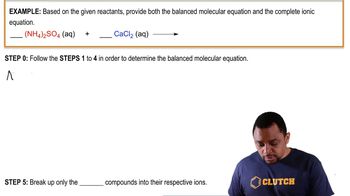An aqueous solution of an unknown solute is tested with litmus paper and found to be acidic. The solution is weakly conducting compared with a solution of NaCl of the same concentration. Which of the following substances could the unknown be: KOH, NH3, HNO3, KClO2, H3PO3, CH3COCH3 (acetone)?
Ch.4 - Reactions in Aqueous Solution

Brown14th EditionChemistry: The Central ScienceISBN: 9780134414232Not the one you use?Change textbook
Chapter 4, Problem 39
Complete and balance the following molecular equations, and then write the net ionic equation for each:
(a) HBr(aq) + Ca(OH)2(aq) →
(b) Cu(OH)2(s) + HClO4(aq) →
(c) Al(OH)3(s) + HNO3(aq) →
 Verified step by step guidance
Verified step by step guidance1
Identify the reactants and products in the given molecular equation: Cu(OH)_2(s) + HClO_4(aq).
Write the balanced molecular equation by ensuring the number of atoms of each element is the same on both sides of the equation.
Dissociate all strong electrolytes into their ions. In this case, HClO_4 is a strong acid and will dissociate into H^+ and ClO_4^- ions.
Identify the solid, liquid, or gas products that do not dissociate into ions. Cu(OH)_2 is a solid and does not dissociate.
Write the net ionic equation by removing the spectator ions (ions that appear on both sides of the equation) from the complete ionic equation.

Verified video answer for a similar problem:
This video solution was recommended by our tutors as helpful for the problem above.
Video duration:
5mWas this helpful?
Key Concepts
Here are the essential concepts you must grasp in order to answer the question correctly.
Balancing Chemical Equations
Balancing chemical equations involves ensuring that the number of atoms for each element is the same on both sides of the equation. This is crucial for obeying the law of conservation of mass, which states that matter cannot be created or destroyed in a chemical reaction. Techniques such as adjusting coefficients and using the smallest whole numbers help achieve balance.
Recommended video:
Guided course

Balancing Chemical Equations
Molecular vs. Ionic Equations
Molecular equations represent the complete chemical formulas of reactants and products, while ionic equations show the ions present in solution. The net ionic equation is derived from the ionic equation by removing spectator ions—those that do not participate in the reaction—thus highlighting the actual chemical change occurring.
Recommended video:
Guided course

Molecular and Complete Ionic Equations Example
Net Ionic Equations
A net ionic equation focuses on the species that undergo a change during the reaction, omitting the spectator ions. This equation provides a clearer picture of the actual chemical process, allowing for a better understanding of the reaction dynamics. It is particularly useful in reactions involving soluble ionic compounds in aqueous solutions.
Recommended video:
Guided course

Net Ionic Equations
Related Practice
Textbook Question
1316
views
Textbook Question
Classify each of the following substances as a nonelectrolyte, weak electrolyte, or strong electrolyte in water: (a) HF (b) C6H5COOH (benzoic acid) (c) C6H6 (benzene) (d) CoCl3 (e) AgNO3.
755
views
Textbook Question
Write the balanced molecular and net ionic equations for each of the following neutralization reactions: (a) Aqueous acetic acid is neutralized by aqueous barium hydroxide
535
views
Textbook Question
Write the balanced molecular and net ionic equations for each of the following neutralization reactions: (b) Solid chromium(III) hydroxide reacts with nitrous acid.
640
views
Textbook Question
Write the balanced molecular and net ionic equations for each of the following neutralization reactions: (c) Aqueous nitric acid and aqueous ammonia react.
523
views
